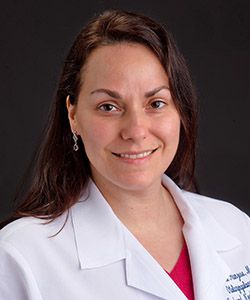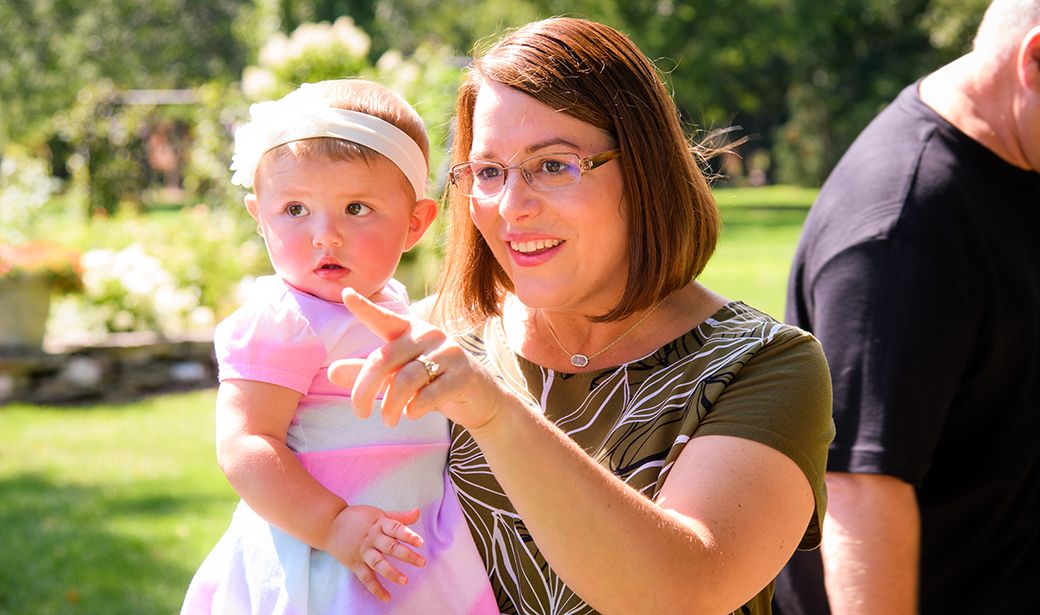Ellen Emmons is technically an empty-nester, but her home in Auxvasse, Missouri, still bustles with activity most nights of the week.
Her oldest daughter’s family lives just a few minutes away, so that means frequent family get-togethers and plenty of time to spend with new granddaughter Parker, who just turned 1. Emmons’ life seemed picture perfect in 2018, but when she viewed family snapshots taken last year, she noticed something odd about her appearance.
“I’d gone to visit my two nieces, and we took cell phone pictures with them at dinner,” Emmons said. When I looked at the pictures on my phone afterward, I had kind of a one-eyed pirate look.”
Emmons’ squinting eye never caused any pain and she didn’t think it was anything serious, so she didn’t see a doctor for it. But about the same time, her throat began to hurt. That’s when she decided to see otolaryngologist Christine Franzese, MD, at University of Missouri Health Care. Franzese examined her throat, diagnosed her with tonsil stones and recommended a tonsillectomy.
During that appointment, Emmons brought up the problem with her right eye.
“She immediately identified it as silent sinus syndrome,” Emmons said. “I had never heard of it, but she was pretty sure that’s what it was. That night I went home and Googled it. The first picture that popped up, I said, ‘That’s me.’ ”
Silent sinus syndrome is a rare condition that can become serious if left untreated. People with the disorder have a droopy eyelid that gives them the appearance of squinting. The condition eventually can lead to peripheral vision loss and double or blurry vision.

“Silent sinus syndrome occurs when one of your cheek sinuses becomes clogged and secretions get trapped in there, then resorb,” Franzese said. “Over time, you end up with a vacuum, and the sinus gets smaller and smaller, causing the eye to droop. It doesn’t cause any pain, so that’s where the silent part comes from.”
Its cause isn’t known. Franzese said there are no known ways to reduce your risk of developing it.
“A lot of people that come to me for silent sinus syndrome treatment have had the condition for a long time,” Franzese said. “They’ve just not seen somebody who has recognized it.”
Franzese ordered a CT scan of Emmons’ sinuses to confirm the diagnosis. Just minutes after completing the scan, Franzese viewed the image and showed it to Emmons.
“I have no medical background whatsoever, and even I could see the right-side sinus cavity was about a third the size of the left side,” Emmons said.
Franzese operated on Emmons in September, removing her tonsils and clearing the blockage to the sinus under her right eye.
“This is something that can be treated by any otolaryngologist that does sinus surgery,” Franzese said. “But it is more difficult than routine sinus surgery because it involves a very small sinus that’s extremely close to the eye. It’s more risky, so you want someone with a lot of experience performing the procedure.”
After surgery, Emmons took three weeks off from her job at Shelter Insurance to rest at home. She used sinus rinses to speed her recovery. Emmons said she was looking better about seven months after surgery.
“It’s not an instantaneous fix,” Franzese said. “Because bones are involved, it can take several months to notice improvement. In severe cases, you may need to see an eye doctor to put extra support under the eye.”
By summer, Emmons’ eye had returned to normal. She is happy to have her silent sinus syndrome episode behind her, but it’s given her a conversation topic to discuss with friends and co-workers.
“I had a friend who wanted to tell another friend with a droopy eye about this condition,” Emmons said. “She said, ‘I wonder if they know about it?’ I had no idea it existed. But, thankfully, Dr. Franzese did.”
During a trip to Shelter Gardens in Columbia on a pleasant July afternoon, Emmons didn’t hesitate to pose for pictures with little Parker in front of the water features. She knew the snapshots would be squint-free.



